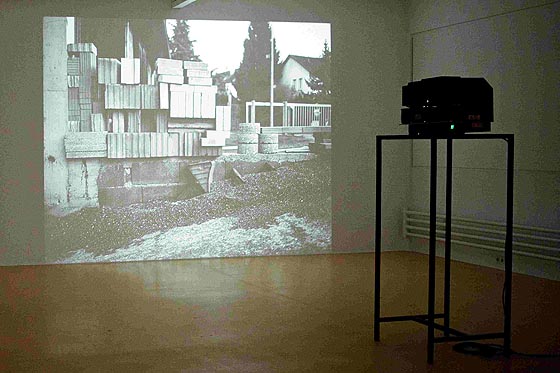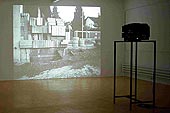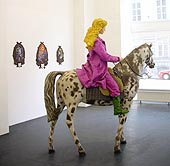
translated and summarized by: Liz Wollner-Grandville,
English summaries March 12 - 25
Generali Foundation
Morgan Fisher – The Frame and Beyond
02.03.2012 – 29.07.2012
By Patrick Schabus
The camera zooms in on the cinema. Arriving there, it moves into the auditorium, nobody is there, everything is still dark. But the projector is running without a film and projects only white light onto the screen. Then the film comes to an end and the projector projects – now in front of the respective audience – the same white light onto the screen as shown in the film before.
That is "Screening Room", a film by Morgan Fisher. It is only allowed to be shown in one cinema, for which a special version has been created. As part of a retrospective (May 9 and 10, 2012) the Film Museum will re-shoot this work for the room in the Film Museum, whereby it will be possible to view this hitherto seldom-shown film again and perhaps more frequently.
His interest in films began when he was still a child. Back then, he found a 16mm film that had been washed up on the shore of a lake. Even then, he fascinated by the medium, and not by what it showed. And he was particularly fascinated by the perforations without which a film would have not been projectable. There were other artists who later influenced him although he had known the filmmaker, Thom Andersen, for a long time. Because he didn't live in New York, he was relatively excluded from the then avant-garde scene. It was Duchamp, Warhol, Sol LeWitt, Carl Andre and others who influenced him.
His work has been shown at the Dokumenta Kassel, the Museum of Modern Art NY and other diverse important institutions of applied arts. In many museums, works for future exhibitions lie dormant - in short, the shimmering art world has long since enveloped him into its centre. He had already made his first film installations in the 70’s; his first film is from 1968. His films frequently address the production requirements of commercial Hollywood Films, are partly autobiographical and extremely aesthetically reserved.
For his last film () (Parenthesis) from 2003, he took 16mm films which he bought on eBay, took every insert he could possibly find and constructed his own work from them. Mostly it shows working hands – apparently almost all of them are taken from films – but there is also documentary material. There is, for example, a coloured shot from a movement study film by Lilian and Frank Gilbreth in which a clock can be seen which is like that in his 1973 film "Picture and Sound Rushes" and which he placed to his right on a table. According to him, the film could also last for a 100 years, and if he were to build on the same principle of a continuous row of inserts, it would still be the same film.
Again and again, his works deal with the (im)possibility of not being able to be expressive as an artist. The Generali Foundation is now showing a compilation of his forays into the moving and the unmoved.
The visitor to the exhibition sees some pictures, which appear to resemble the colour field paintings of Ellsworth Kelly. One of the accompanying texts makes it clear that it's not several works but rather a single large one. Exploring the room further, one sees a projected video on the wall. Here, two gloves are being touched, kneaded and stroked slowly, almost timidly. Next to it is a video in which we see a person sitting directly opposite us and who is slowly cutting himself off from the surrounding world by putting on several pieces of clothing, which altogether are meant to protect the entire body. Both are very plain and slow, almost meditatively calm. One can soon find the drawings by Fischer, beginning with those done in 1968. Immediately upon entering the area where they are presented, one sees images of film cans, which have been created by spraying paper templates onto paper. Immediately next to these works are several drawings that have been developed from other topics, from atlases, guidebooks or his body measurements. Here is a new possibility to see Fisher's work: on close inspection, it becomes evident that his interest lies in the production requirements and the standards of the respective media.
And if one goes further, with new knowledge, one finds some of the films in large, walk-in boxes. This cinema is completely different, hermetic, while there's a coming and going in these boxes, and the outer space, with all its sounds, is still present so that the observer is always interrupted and is unable to concentrate. Fischer once showed his films in another way: when he was exhibiting in 2011 in the British art room Raven Row, the visitor could start the film by pressing a button. Here, unfortunately the films run in a loop.
On May 11 and 12, 2012, and following the conclusion of the presentations in the Austrian Film Museum, the symposium "Beyond the Frame: How and Why" will take place.
Generali Foundation
1040 Vienna, Wiedner Hauptstrasse 15
Tel: 01/504 98 80
Fax: 01/504 98 83
foundation.generali.at
Opening hours: Tue-Fri 11-18, Thu 11-20, Sat, Sun 11-16 hours
Magazin4
David Heitz – In Contact (Motive)
03.03.2012 – 20.05.2012
By Wolfang Ölz
The "Magazin4" in Bregenz is a niche player, even if – on the occasion of its 20th anniversary - it is cited to belong to the "most prestigious Austrian art institutions". A short glance at the exhibition archives confirms that this superlative is definitely appropriate. "Magazin4" has had a good run over two decades without taking the quota into consideration (visitors aren't even counted) or the public taste (roughness and outlandishness are deliberately taken into account). It's just natural in the exhibition rooms that a world star like Ayse Erkmen was feted at the Biennale in November 2011, so that – note the timing – in December 2011, he could set the Bregenz public agape (see the artmagazine article). The location in the former grounds of the "Birk" firm as the fourth of formerly four magazines, virtually door-to-door with the Lisi Hämmerle Gallery, a stone's throw from Bregenz's Art Hall and the magnificent new construction of the "Vorarlberg Museum", definitely has a future.
The 20th birthday will be celebrated with the artist, David Heitz, who has decided to devote his work to the Bregenz small-town Idyll and has, with an aesthetically perfect yet somehow oppressive black-and-white photo series, found grotesque and absurd moments that remind one more of the GDR than a bourgeois little town on the Bodensee, which is also the capital city of Vorarlberg. Heitz relieves the regional myths about "üserm subra Ländle" (our clean little land) of their plausibility. In an endless loop, the pictures range from views of the Swabian Sea (the Bodensee) with streets and halt signs to an old BMW with flat tyres. Dirty yachts in the harbour or a bullet hole in a jeweller's shop show something one looks for in vain in a guide book or coffee-table book but which does, in fact, exist. The photocopied scenes swing between gaudy narration and subtle abstraction. The lines on a cobblestone pavement show, on the one hand, the aged form of the street surface and on the other, they remind one of the whole history of Modernism which culminated with Barnett Newman. In brief: "Magazin4" celebrates David Heitz, who received the "Columbus Advancement Award for Contemporary Art" – one of the highest German art prizes in this category, on its customary high standard. And also the group exhibition, "Right of Refusal" planned for the summer 2012 and "Movement in Winter" 2012/2013 promise to be just as interesting as Felix Schramm's single exhibition, "Intersection".
Magazin 4
6900 Bregenz, Bergmannstraße 6
Tel: +43 / 5574 / 41 01 51 1
Fax: +43 / 5574 / 41 01 50 0
E-mail: mail@magazin4.at
www.magazin4.at
Opening hours: Wed-Fri 16-19, Sat, Sun 12-16 hours
Galerie Steinek
Settled
7.03.2012 – 13.04.2012
By Susanne Rohringer
One can hardly believe it. The Steinek Gallery in the Eschenbachgasse is celebrating its 30th birthday this year.
Silvia Steinek is presenting "Settled", with works by artists in her gallery, as the first in the series of jubilee exhibitions. Upon entering the first room, one has to walk around a horse with rider – a work by the Salzburg artist, Peter Brauneis, who appears to compare "settled" with being mounted. Ilse Haider’s work, in her usual perfect manner, encapsulates the dilemma of life. Two stacking chairs are wedged into one another and tied together by means of fibre optic cables – yes, truly woven together. They attract each other and simultaneously push each other apart. "Stay or Go" – such is the apt title of this work. Suffering through others and oneself is also the basis of the works by Gudrun Kampl, as well as those of Matthias Herrmann, Julius Deutschbauer and Ilse Haider, all of whom have been represented by Silvia Steinek since 1990. Gudrun Kampl wonderful relief-like chairs are presented in the exhibition. They appear to have been carved in ranks out of cardboard with a fretsaw, and covered with velvet, conveying the appearance of Baroque chairs.
Matthias Herrmann presents his work "pig pieces”: photographs in which he re-enacts himself by means of different seating accommodations. He sometimes wears a pig's mask - an ironic citation that points to prejudices towards his work.
Newcomers to the gallery are Martin Schnur and Karen Holländer, and the young artists Olga Georgieva and Clemens Wolf. Austrian artist Karen Holländer’s work is remarkable: in one picture, Holländer created an eclectically designed self-portrait in which she paints herself in her atelier in different guises and poses. In one, her body hangs down from a horizontal bar, the skirt puffing out in folds over her upper body. Besides the large format, there's also a sort of painted chair where Holländer presents herself in a sitting position. She's holding a ball of wool in her lap and wears a T-shirt with the word "Hope”.
Last but certainly not least, one should look at a further chair in the gallery. A very important artist for the Steinek Gallery is represented here: Julius Deutschbauer – he covered a simple wooden chair with photographic paper showing Silvia Steinek with an injured leg and crutches. Deutschbauer originally made this photograph into a placard with the title "God Save Austria" at the time when the rightist government came into power in the year 2000. The affronted gallery owner is portrayed here as a synonym for the "deranged" Austria.
In talking to her, Silvia Steinek looks back at the beginnings of the gallery benignly. On the one hand, she's amazed that so many years have really gone by. She doesn't really feel as if she is still at the beginning but rather in the middle. Above all, she is extremely thankful to her father with whom she founded the gallery in the Himmelpfortgasse in 1982. He, Heinrich, is an avid collector and art connoisseur and brought his daughter, Silvia, into contact with art at a very early age. Artists such as Adolf Frohner and Walter Vopava belong to his circle of friends and were exhibited in the early years until Silvia Steinek developed her own profile more and more during the course of the 90's. The Steinek Hall was opened in 1990 in Vienna's 9th district in the Pramergasse, and is a grand presentation platform for the gallery's artists where they can show works from their studios to interested collectors. In 2006, the gallery moved to Eschenbachgasse.
How will things continue? It's very important to Silvia Steinek, who takes great pride in the successful interaction between artists and gallery owner, to keep her eyes open all the time and to work constantly towards achieving a congenial atmosphere for both customers and artists. Her next step is to go to Art Brussels with her artists. Further exhibitions in the Eschenbachgasse on the theme of "Thirty Years Gallery Steinek" will follow this year.
Galerie Steinek
1010 Vienna, Eschenbachgasse 4
Tel: +431/512 87 59
Fax: +431/512 87 59
E-mail: galerie@steinek.at
galerie.steinek.at
Opening hours: Tue-Fri: 13:00-18:00; Sat: 11:00- 5:00 hours
Kunstraum Innsbruck
Martin Soto Climent – The Bright of the Whisper
11.02.12 – 05.04.12
By Manisha Jothady
The Mexican artist Martin Soto Climent (born 1977) created a fascinating, and at the same time disturbing, installation for his first solo presentation in Austria. His work is based on the symbolic transformation of diverse objets trouvés. Door wings placed on chairs create shelf space for a conglomeration of everyday objects including a chess game, trinkets, spinning wheels, leather gloves and lace underwear. At the same time, the door-chair constructions serve as the base for a mesh of nylon stockings that are stretched to the ceiling, and in their waistbands one may find a hot water bottle, a cake tin, or wisps of hair. Women’s boots create a wall sculpture, a curtain laid in folds flowing into the boots, a pair of high heels on the floor, and a bra hanging on the wall. Without doubt, the artist enjoys playing with the fetish-quality inherent to erotic female accessories. But through the irritating concatenation with other details of the installation, through the unusual, partly contradictory play of the objects, Soto Climent lets the visitor surmise that these are not solely meant as references to the human body.
He is much more interested in stimulating the world of things. The accompanying text of the exhibition therefore refers to the “animism of objects”, to sounding out their “state”. By giving familiar objects in irrational context and reviving lifeless things, the artist positions himself close to the surrealists. The mysteriousness of his art also seems to thrive on an unfathomable form of thinking. The exhibition clearly proves that Soto Climent opts out of the conventions of a collective understanding of reality. He creates a cosmos that seems to follow its own laws. But whatever it is that he wants to tell us, it is impossible to decode his message completely.
Kunstraum Innsbruck
6020 Innsbruck, Maria-Theresien Strasse 34
Tel: +43 512 58 4000
Fax: +43 512 58 4000 15
Email: office@kunstraum-innsbruck.at
www.kunstraum-innsbruck.at
Opening hours: Daily 18 – 22 hours
Mehr Texte von translated and summarized by: Liz Wollner-Grandville


 Teilen
Teilen




